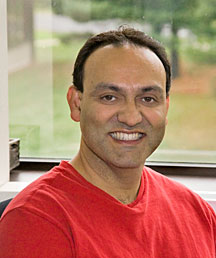- Number 384 |
- March 18, 2013
Maingi adds a new strategic dimension to fusion and plasma physics research

Rajesh Maingi
Physicist Rajesh Maingi remembers nearly everything. Results of experiments he did 20 years ago play back instantly in his mind, as do his credit card and bank account numbers.
His knack for recalling research results comes in particularly handy. “Knowing results from five-to-20 years ago makes it easier to ask the right questions for contemporary scientific programs,” Maingi said. Such findings have made him a leading expert on key aspects of the physics of plasma, the superhot, charged gas that fuels fusion reactions in donut-shaped magnetic facilities called tokamaks.
Maingi brings his expertise to the new position of manager of edge physics and plasma-facing components at the U.S. Department of Energy’s Princeton Plasma Physics Laboratory (PPPL). The recently created post calls for coordinating all Laboratory research on the volatile edge of the plasma, which must be carefully controlled for fusion to take place, and on the crucial boundary between the plasma and the interior surfaces of a tokamak.
The strategic position adds a new dimension to research at PPPL. “We’ve decided to pull all our activities in this area together and plan how to use them to make an impact in the fusion community and the world,” said Michael Zarnstorff, deputy director for research at the Laboratory. “Rajesh is well-known around the world, particularly in tokamak physics. He has experience and perspective and strategic vision, and we see him as a great opportunity for the Lab.”
Maingi is no stranger to PPPL. From 1999 to 2012 he was on long-term assignment from Oak Ridge National Laboratory to the National Spherical Torus Experiment (NSTX), the major fusion facility at PPPL. Now, as a newly hired PPPL staffer, he is on two-year assignment to the DIII-D fusion facility at General Atomics in San Diego while the NSTX is being upgraded, and remains deeply involved in long-term planning for NSTX experiments.
Maingi fell in love with fusion during a 12th grade physics class in Raleigh, North Carolina. His family had moved there from India when he was five. While writing his senior-class paper on fusion, he decided to make it his career. “Most people aren’t that fortunate,” he says. “They have to flounder around a little longer.”
What particularly fascinates Maingi is the transition the plasma makes from its blistering core—“the hottest thing in the universe,” he says—to its far cooler outer regions that lie just a few meters away in tokamaks. The challenge is to manage this transition so that the core remains hot enough to maintain fusion reactions, without allowing the outer layers to damage components of the tokamak that face the plasma. Maingi has pursued this challenge since earning his doctorate from North Carolina State University and joining Oak Ridge in 1992.
Maingi calls the edge of the plasma—the one-to-two centimeter section of gas found just inside the boundary layer—“the tail that wags the dog.” Controlling this edge is vital to preventing the sudden eruptions of heat called “edge localized modes” that can destroy the divertor plates that vent exhaust from fusion reactions. Researchers have achieved a measure of such control on the NSTX, “and that by itself is very exciting,” Maingi said.
Maingi shares his enthusiasms with budding scientists, mentoring student projects at the Laboratory from the high school to the post-graduate levels. Such projects have both short- and long-term benefits, he says. On the one hand, the student work can augment his own research. On the other hand, “There’s a lot of satisfaction in seeing one or more of your students progress into scientists, particularly if they stay in the field,” Maingi said.
Scientific curiosity runs in the Maingi family. Among the students that Maingi has mentored is his younger son, Raman, who co-authored two journal-published papers as a high school summer intern at PPPL in 2010 and 2011. Raman now studies political science as a sophomore at Rutgers University. His older brother, Logan, is a graduate student in theoretical particle physics at Johns Hopkins University. Maingi and his wife, Nola, have a third child, Jillian, who is in kindergarten.
Maingi likes to relax by playing touch football, with quarterback his favorite position. While living in Plainsboro, he organized weekly games in the summer at an open field near his home. “Kids of all ages and a handful of dads and I would go out there,” he said. “It was wonderful and a great way to stay in shape. You watched all the kids grow up and it gave them a great pastime.”[John Greenwald, 609.243.2672,
jgreenwa@pppl.gov]
